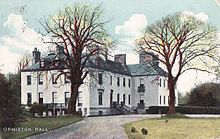- Ormiston
-
For the Ormiston in Australia, see Ormiston, Queensland. For people named Ormiston, see Ormiston (surname).
Ormiston is a village in East Lothian, Scotland, UK, near Tranent, Humbie, Pencaitland and Cranston, located on the north bank of the River Tyne at an elevation of about 276 ft.
The village was the first planned village in Scotland, founded in 1735 by John Cockburn (1685–1758), one of the initiators of the Agricultural Revolution.
Contents
Name
The word Ormiston is derived from a half mythical Anglian settler called Ormr, meaning 'serpent' or 'snake'. 'Ormres' family had possession of the land during the 12th and 13th centuries. Ormiston or 'Ormistoun' is not an uncommon surname, and Ormr also survives in some English placenames such as Ormskirk and Ormesby. The latter part of the name, formerly spelt 'toun', is likely to descend from its Northumbrian Old English and later Scots meaning as 'farmstead' or 'farm and outbuildings' rather than the meaning 'town'.
Design
The village consists mainly of a broad Main Street, with a row of two storey houses along each side. It crosses two bridges, one over the now redundant railway route, and the other a narrow bridge over the river. Using strict guidelines for its appearance, John Cockburn put housing for artisans and cottage industries (spinning and weaving) around the original mill hamlet. When he did not achieve the expected return on his investment, he sold it to the Earl of Hopetoun in 1747. The linen trade became a failure, and by 1811 the distillery shut down. A brewery and one of Scotland's first bleachfields were also built here as well. Ormiston later became a mining village (Ormiston Coal Company).
Ormiston Coal Co. Ltd.
The principal collieries at Ormiston were:
- Limeylands (NT406695, 1 km west of the Mercat Cross), opened 1895, closed 1954, though the Coal Preparation Plant stayed in use until about October 1958.
- Tynemount (NT401686, 1.5 km west-south-west of the Mercat Cross), opened 1924, closed January 1952, but not formally abandoned until 1962.
- Oxenford No. 2 (NT393678, south-west of Tynemount), opened 1926, closed 1950.
- Oxenford No. 3 (NT393677), a new pit very close by, was opened by the National Coal Board, but closed in 1952.
- Winton Mine (NT421699), first provided for ventilation purposes in 1943, but developed as a mine by the National Coal Board in 1952, closed in 1962.
- Source 1: Industrial Locomotives of Scotland, Alan Bridges (ed.), Industrial Railway Society, Market Harborough, 1976, ISBN 0901096245
- Source 2: Scottish Collieries: An Inventory of the Scottish Coal Industry in the Nationalised Era, by Miles K. Oglethorpe, RCAHMS, Edinburgh, 2006, ISBN 9781902419473.
Ormiston Hall
Ormiston Hall was built for Cockburn (1745–48) and was later extended for the Earl of Hopetoun. The remains of the pre-Reformation St Giles Parish Church can still be seen.
The Great Yew of Ormiston can be found close to the ruins of Ormiston Hall. The huge central trunk measures 6.9 metres (22 feet 10 inches) in girth.
Shops in Ormiston
There are Shops in Ormiston:
- The Co-op Store (The Co-operative)
- Post Office
- The little Superstore
- The Dragon Way (Chinese)
- Post Office
- Lorraine's Shop
Mercat Cross
The 15th-century pre-Reformation Mercat Cross on Main Street is unusual for its truly cruciform shape, with three modern steps and a railed enclosure.
Notable people with Ormiston connections
- Birthplace of the Scottish Congregationalist missionary Robert Moffat (December 21, 1795 - August 9, 1883); a memorial is erected in his name. He was the father-in-law of David Livingstone, the medical missionary and explorer.
- The religious reformer and Protestant martyr George Wishart was captured in December 1545 by the Earl of Bothwell while hiding at Ormiston Hall.
Photo gallery
See also
External links
Gazetteers
History
Community
- East Lothian council: Ormiston Community Profile
- Ormiston village website
- Ormiston Primary School website
- Ormiston Library (East Lothian Council)
Environment
- Forestry Commission Scotland: The Great Yew of Ormiston (taxus baccata)
- Pencaitland and Ormiston Community Path Network
Aberlady · Athelstaneford · Auldhame & Scoughall · Bolton · Cockenzie and Port Seton · Dirleton · Drem · Dunbar · East Linton · East Saltoun and West Saltoun · Gifford · Gullane · Haddington · Humbie · Innerwick · Kingston · Longniddry · Macmerry · Musselburgh · North Berwick · Oldhamstocks · Ormiston · Pencaitland · Prestonpans · Tranent · Whitekirk and Tyninghame · WallyfordCategories:- East Lothian
- Villages in East Lothian
Wikimedia Foundation. 2010.




